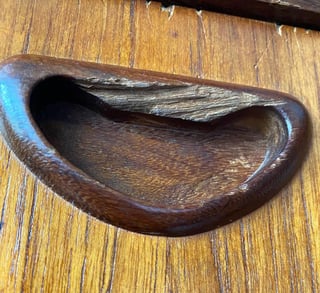I have acquired a Danish vintage teak sideboard with distinctive inset wooden handles that the designer used on a range of pieces. Unfortunately, one of the handles has been damaged over the years and I would love to restore it in some way and would greatly value any advice.
Here is a picture of the handle in a good state. I imagine that the handles were made separately and then glued unto a routed-out hole in the face of the panel. There is no sign of the hole on the reverse face, of course.
Image from Via Antica
Here is a picture of the broken handle. I guess there is an option of trying to build up new material onto this one, but the handle takes all the force of opening the panel, and I think that this is bound to fail.
I have been offered a spare drawer-front with the same design of handle and so my question is what would be the approach to remove both the good and the bad handles in such a way that the good one then could be inserted back into the panel?

